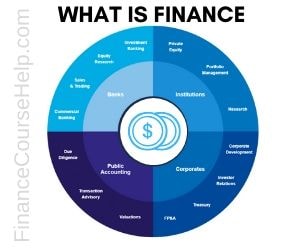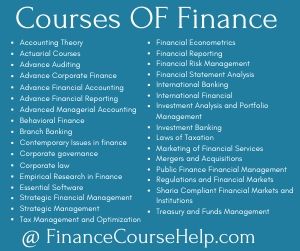FinanceCourseHelp
Get Finance Help Online
Get Finance Help Online
 The finance assignments are mostly linked with the corporate industries and it is named as industry finance or business finance. Many experts and sites help students so that they provide different multidimensional methods. These methods will help a student to cover all the concepts of a subject.
The finance assignments are mostly linked with the corporate industries and it is named as industry finance or business finance. Many experts and sites help students so that they provide different multidimensional methods. These methods will help a student to cover all the concepts of a subject. Accounting Theory
Accounting TheoryInternational Financial Management
International financial management is the most common topic which is given to students to start any project.
This concept is consider as liberalization. Globally many people want to start their own business in the world. Finance students can be those entrepreneurs who want opportunities even if they are not in their internal environment.
 Financial Planning and Forecasting
Financial Planning and Forecasting
There is a lot of differences in financial planning and forecasting.
The financial plan of a company layout the steps in sequence format, first the step starts with identifying the available capital and the requirements and need of assets in order to gain the profit.
A financial plan defined as “the process of putting the right resources (labor, raw material and assets) to generate the maximum revenues and possible profits. Students who have this subject or course so they must buy a guidebook which will tell them the different financial positions and what can be done to meet the required goals.
The plan covers all the aspects of financial life starting with investing and getting profit.
Accounting Project Help
This process is part of every accounting project. The students must know the working cash and capital flows of a company which they are studying. Remember the company must be international company.
They can study their plans over a period of time and must analyze the expenses which are occurred during the period. This helps them learning new ideas to open different business and they can easily make projections whether to make investments on not.
Bond Valuation
Bond valuation is very important for finance student. The students through the prices of bonds, they evaluate the future price of bonds. If they have face value, coupon rate and market value in front of them then they can analyze the future rates of bonds.
Investment Analysis and Portfolio Management
Portfolio management is defined as the art and science of making decisions about investment according to the company policies. The aim of management is to create a matched between investments and the company objectives. It also includes the allocation of asset for organizations, individuals and institutions.
The main purpose of portfolio management is to determine the strengths, weaknesses, opportunities and threats when the finance manager is making choice between its debt and equity, growth and safety and other trade-offs which are faced in an organization are managed to maximize the profit and minimize the loss ratio.
Students who are enrolled in portfolio management assignment must pay close attention to market trends.
All the external and internal environment impacts can positively and negatively make a change in financial activities.
Public Finance
Public finance is the management of country revenues, debt and expenditures. These outcomes are from different government and quasi government institute. The students who are studying public finance this is the guide for them. They must know the components of public finance.
International Flow of Funds
International financial flows of funds take a variety of forms. One of the most important category is foreign direct investment.
Credit and Inventory Management
In this topic the students are given cases that if a company want to produce certain units in numbers how much they will produce.
The students must know the steps to manage the credit which includes account receivables and payable, also they must know how to manage their resources to avoid scarcity faced by organizations.
Cash and Liquidity Management
Availability of cash in the organizations means that it has strong liquidity to pay off its debt and expenses that might occurred unexpectedly. If the manager doesn’t know that how much cash he must put in his bank and how much in his office, then he cannot manage the activities of the organization.
It is very essential for a student to study this chapter thoroughly, and many students get assignments based on this topics. If your teacher ask you to do an assignment on your topic. You can select this topic.

| VALUATION OF NECKTEK NECTER USING FUTURE FREE CASH FLOW MODEL | ||||||||||||
| YEAR | 1997 | 1998 | 1999 | 2000 | 2001 | 2002 | ||||||
| $(000s) | $(000s) | $(000s) | $(000s) | $(000s) | $(000s) | |||||||
| EBIT | 2025 | 4279 | 6964 | 6312 | 10633 | 14698 | ||||||
| add: Depreciation | 209 | 331 | 495 | 710 | 763 | 947 | ||||||
| less: Changes in | ||||||||||||
| working capital | 3207 | 2237 | 3944 | 6402 | 8773 | 11731 | ||||||
| less:Capital expenditure | 350 | 488 | 656 | 861 | 1039 | 1222 | ||||||
| Free Cash flows | -1323 | 1885 | 2859 | -241 | 1584 | 2692 | ||||||
| discounting @10% | 0.909 | 0.826 | 0.7513 | 0.683 | 0.62 | 0.5644 | ||||||
| Diccounted FCF | -1202.607 | 1557.01 | 2147.967 | -164.603 | 982.08 | 1519.365 | ||||||
| Value of Nenycket Necter | 4,839.212 | |||||||||||
| Existing Machine | |||||||||
| Year | 1 | 2 | 3 | 4 | 5 | 6 | 7 | 8 | |
| Cost | 0.415807 | ||||||||
| Expected Sales | 280 | 285.6 | 291 | 297 | 303 | 309 | 315 | 322 | |
| CGS | 252 | 257 | 262 | 267 | 273 | 278 | 284 | 289 | |
| Labour Cost | 0.335 | 0.345 | 0.356 | 0.366 | 0.377 | 0.388 | 0.400 | 0.412 | |
| Maintenance | 0.004 | 0.0041 | 0.0042 | 0.0044 | 0.0045 | 0.0046 | 0.0048 | 0.0049 | |
| Electrcity Charges | 0.0123 | 0.0127 | 0.0130 | 0.0134 | 0.0138 | 0.0143 | 0.0147 | 0.0151 | |
| Assumed medical claims per year | 0.1 | 0.1 | 0.1 | 0.1 | 0.1 | 0.1 | 0.1 | 0.1 | |
| Depreciation | 0.069301167 | 0.06930 | 0.06930 | 0.06930 | 0.06930 | 0.06930 | 0.00000 | 0.00000 | |
| OCF | 27.479 | 28.029 | 28.589 | 29.161 | 29.743 | 30.338 | 31.013 | 31.631 | |
| Add Back Dep | 0.069301167 | 0.069301 | 0.069301 | 0.069301 | 0.069301 | 0.069301 | 0 | 0 | |
| Free Cash Flows | 27.549 | 28.098 | 28.658 | 29.230 | 29.813 | 30.407 | 31.013 | 31.631 | |
| Residual Value | 0.11 | ||||||||
| Tax | 43% | 11.846 | 12.082 | 12.323 | 12.569 | 12.819 | 13.075 | 13.336 | 13.649 |
| After Tax CF | 15.703 | 16.016 | 16.335 | 16.661 | 16.993 | 17.332 | 17.677 | 18.092 | |
| Tax Savings | 0.0298 | 0.0298 | 0.0298 | 0.0298 | 0.0298 | 0.0298 | 0 | ||
| Net CF | -0.415807 | 15.7325 | 16.0457 | 16.3651 | 16.6908 | 17.0230 | 17.3617 | 17.6774 | 18.0924 |
| DF | 9.86% | ||||||||
| NPV | $12.66 | $24.76 | $36.00 | $46.43 | $56.12 | $65.11 | $73.44 | $81.21 | |
| IF DF | 13.34% | ||||||||
| NPV | $11.88 | $69.36 | |||||||
| VALUATION OF BELL CANADA ENTERPRISES | ||||||||||
| *All assumptions are taken from the case | ||||||||||
| *All figures are in $ million except share price | 2006 | 2007 | 2008 | 2009 | 2010 | 2011 | 2012 | |||
| Total Revenue | 29,003 | 29,438 | 30,145 | 30,838 | 31,393 | 31,989 | 32,597 | |||
| EBITDA Margins | 36.3% | 37.5% | 38.6% | 38.6% | 38.6% | 38.6% | 38.6% | |||
| EBITDA | 10,528 | 11,039 | 11,636 | 11,903 | 12,118 | 12,348 | 12,583 | |||
| Tax rate | 15% | 15% | 15% | 15% | 15% | 25% | 25% | |||
| After tax - EBITDA | 8,949 | 9,383 | 9,890 | 10,118 | 10,300 | 9,261 | 9,437 | |||
| Plus: Depreciation | 4,960 | 5,004 | 5,125 | 5,242 | 5,337 | 5,438 | 5,542 | |||
| Less: CAPEX | (2,646) | (2,707) | (2,755) | (2,808) | (2,862) | |||||
| Less: Working capital | (17) | (28) | (28) | (22) | (24) | (24) | ||||
| Free Cashflows | 54,848 | 54,121 | 55,367 | 56,370 | 56,205 | 57,272 | ||||
| Discount rate | 7.7% | 7.7% | 7.7% | 7.7% | 7.7% | 7.7% | ||||
| Discounted Free Cashflows | 50,912 | 46,633 | 44,283 | 41,851 | 38,734 | 36,637 | ||||
| Growth rate | 1% | |||||||||
| Terminal Value | 549,829 | |||||||||
| Value of the Buiness | 808,879 | |||||||||
| Value of Non core assets: | ||||||||||
| Bell Aliant | 2,659 | |||||||||
| CTV Globemedia | 300 | |||||||||
| Clearwire & SkyTerra | 530 | |||||||||
| Total Non core assets | (3,489.21) | |||||||||
| Net value of Business | 805,390 | |||||||||
| No. of Shares | 806.35 | |||||||||
| Value per Share | 999 | |||||||||
| Discounted Cash Flows $000 | ||||||
| Analysts' estimates of growth rates | ||||||
| Estimated growth rate | 0.0930 | |||||
| Estimated terminal growth rate | 3% | |||||
| Cost of capital | 14.33% | |||||
| Method 1: Using EBITDA as OCF | ||||||
| 1993 | 1994 | 1995 | 1996 | 1997 | Terminal Value | |
| FCF | 2573 | 4332.5 | 3791.37 | 4074.19 | 4383.2 | 38686.94404 |
| Terminal Value at t=5 | ||||||
| Discount factor | 14.33% | |||||
| NPV | 51417 | |||||
| Value of Firm | 51417 | |||||
| Minus Total liabilities (2013 data) ($M) | 4512 | |||||
| MV of Equity ($M) | 46905 | |||||
| Shares outstanding (M) | 2572 | |||||
| Price per share ($) | 18.2346526 | |||||
| RATIOS | ||
| 1994 | 1995 | |
| Profitability | ||
| Return on Sales | 32% | 33% |
| Return of assets | 34% | 49% |
| Return on equity | 129% | 139% |
| Liquidity | ||
| Quick Ratio | 2.980 | 3.309 |
| Current Liabilities to Cash flow from Operations | 0.513 | 0.473 |
| Solvency | ||
| Total debt to equity | 2.770 | 1.836 |
| Interest Coverage | 0.118 | 0.066 |
| Asset Management | ||
| Total asset turnover | 1.088 | 1.506 |
| Activity Levels | 7-Jul | 8-Jul |
| Sales | 1,300,000 | 1,500,000 |
| Lines | 30,500 | 18,100 |
| Orders | 2,900 | 1,733 |
| Deliveries | 55 | 55 |
| Days sales outstanding | 3.47 | 3.58 |
| SKUs | 2,245 | 2,400 |
| Days in Month | 31 | 31 |
| Annual Prime Interest Rate | 8.25% | 5.00% |
| Total Inventory allocated to VM in Seattle DC | 2,200,000 | 2,700,000 |
| Driver Rates | ||
| Receivable | 145516 | 173226 |
| Cost per line | $0.55 | $0.55 |
| Cost per order | $2.93 | $2.93 |
| Forecasted Income Statement(working for DCF) | |||||
| 1999 | 2000 | 2001 | 2002 | 2003 | |
| EBIDTA | $ 302,602.00 | ||||
| Growth Rate | 11% | 11% | 11% | 11% | |
| Forecasted EBIDTA | $ 302,602.00 | $ 335,815.09 | $ 372,673.59 | $ 413,577.63 | $ 458,971.22 |
| Income Tax | $ 24,167.00 | ||||
| Growth Rate | 21% | 21% | 21% | 21% | |
| Forecasted Income Tax | $ 24,167.00 | $ 29,216.24 | $ 35,320.43 | $ 42,699.98 | $ 51,621.34 |
| NOPAT | $ 278,435.00 | $ 306,598.85 | $ 337,353.16 | $ 370,877.65 | $ 407,349.87 |
| Name | Year | salary | stock awards | option awards | Incentive | Pension value | All othe Compensation | Total |
| Richard J. Kramer | 2014 | 1,083,333 | 1,447,796 | 2,639,994 | 9,471,870 | 3,121,153 | 88,951 | 17,853,097 |
| Chairman of the Board, | 2013 | 1,050,000 | 925,415 | 2,640,000 | 13,965,003 | 538,440 | 71,642 | 19,190,500 |
| Chief Executive Officer | 2012 | 1,033,333 | 786,504 | 2,249,999 | 9,304,867 | 3,673,172 | 57,849 | 17,105,724 |
| and President | ||||||||
| Laura K. Thompson | 2014 | 508,333 | 164,517 | 299,993 | 1,312,325 | 793,689 | 35,824 | 3,114,681 |
| Executive Vice President | 2013 | 321,667 | 1,007,100 | 318,918 | 1,510,735 | 26,908 | 43,692 | 3,229,020 |
| and Chief Financial Officer | ||||||||
| Darren R. Wells | 2014 | 610,000 | 329,034 | 599,997 | 2,497,396 | 714,245 | 32,929 | 4,783,601 |
| President, Europe, | 2013 | 567,917 | 209,772 | 599,992 | 3,893,987 | 36,634 | 36,507 | 5,344,809 |
| Middle East and Africa | 2012 | 555,000 | 185,136 | 529,646 | 2,674,733 | 846,993 | 33,325 | 4,824,833 |
| Gregory L. Smith | 2014 | 541,667 | 262,885 | 479,391 | 2,017,088 | 311,328 | 33,291 | 3,645,650 |
| Senior Vice President, | 2013 | 525,000 | 733,545 | 479,397 | 3,136,143 | 190,138 | 26,635 | 5,090,858 |
| Global Operations | 2012 | 525,000 | 155,431 | 444,671 | 1,866,980 | 165,295 | 34,848 | 3,192,225 |
| David L. Bialosky | 2014 | 550,000 | 243,484 | 443,989 | 1,856,768 | 420,789 | 25,731 | 3,540,761 |
| Senior Vice President, | 2013 | 540,000 | 155,637 | 443,995 | 2,910,435 | 187,694 | 27,091 | 4,264,852 |
| General Counsel and | 2012 | 533,333 | 146,475 | 419,025 | 2,141,601 | 398,517 | 26,260 | 3,665,211 |
| Secretary |
| PROFITABILITY RATIOS | ||||
| Time Period | 9/30/2013 | 9/30/2012 | 9/30/2011 | 9/30/2010 |
| Gross Profit | 7239 | 2139 | 5456 | 4589 |
| Sales Revenue | 11,778.00 | 10,421.00 | 9,188.00 | 8,065.00 |
| Gross Profit Margin | 61% | 21% | 59% | 57% |
| Operating Profit | $7,239 | $2,139 | $5,456 | $4,589 |
| Sales Revenue | 11,778 | 10,421 | 9,188 | 8,065 |
| Operating Profit Margin | 61% | 21% | 59% | 57% |
| Operating Profit | 7239 | 2139 | 5456 | 4589 |
| Capital Employed | 31621 | 32059 | 31309 | 29910 |
| ROCE | 23% | 7% | 17% | 15% |
| Operating Expenses | $4,539 | $8,282 | $3,732 | $3,476 |
| Sales | 11,778 | 10,421 | 9,188 | 8,065 |
| Operating expenses to Sales | 39% | 79% | 41% | 43% |
| Years | |||||||||
| 0 | 1 | 2 | 3 | 4 | 5 | 6 | 7 | 8 | |
| Purchase Price | ($2,000,000) | ||||||||
| Title and Closing Cost | ($600) | ||||||||
| Fencing Cost | ($2,500) | ||||||||
| Cost of Land Surveyor | ($500) | ||||||||
| Liability Insurance Cost | ($253) | ($256) | ($259) | ($262) | ($265) | ($269) | ($272) | ($275) | |
| Property Appraiser Cost | ($371.51) | ||||||||
| Fees | ($506.00) | ($512.07) | ($518.22) | ($524.44) | ($530.73) | ($537.10) | ($543.54) | ($550.07) | |
| Closing Cost | ($330) | ||||||||
| Sale Price | $ 3,000,000 | ||||||||
| State Transfer Tax | ($14,000) | ||||||||
| Net Cash Flows | ($2,003,600) | ($759) | ($768) | ($777) | ($787) | ($1,168) | ($806) | ($815) | $2,984,845 |
The students can seek financial assignment helps from various writing experts which are at FinanceCourseHelp.
The student practice with tutors and teacher but at the end he attempts and manage the assignment himself.
Many of us want to strengthen the skills and talents in finance, in that terms students must take many finance courses so that it will add value on their resume. Once we begin with the process of assignment, we start it with a detailed discussion with our tutor or expert.
The students must be sure about the assignment criteria and its requirements. A student will use this opportunity as it will help them to understand each process which has to follow by them.
The students have different ideas regarding the topic and they must share the opinions, theme, structure and anything else before making a choice.
Students studying finance courses must be enough competent to complete all homework and projects given by teachers and tutors to attain their degree. Students who are selecting topics for their assignments and projects can select here.
If they will do practical implications on these studies only then they can fulfil the requirement of the home work. Never take these homework for-granted.
Always try to create new ideas, opinions and thoughts that will help you to build a strong portfolio of your homework.
We always give your Finance Assignment & Homework Help before the given deadline.